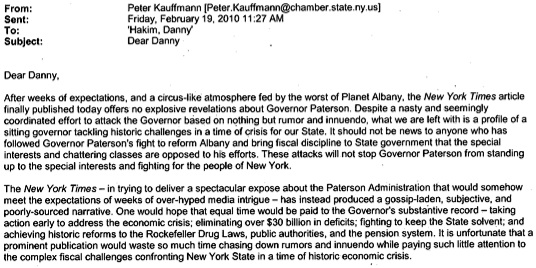While the hundreds of e-mails show the governor’s press staffers fencing with reporters from many major news organizations, no set of interactions is more relevant than those with the New York Times.
The e-mails, mostly coming from Times Albany bureau chief Danny Hakim, reflect the paper carefully gathering string, information, and comment on a variety of subject areas that, for the most part, would eventually appear in a series of articles published between mid-February and early-March. The articles lead to the Paterson’s decision to forgo his already launched 2010 gubernatorial campaign, the establishment of a special counsel, and the departure of some of his administration’s most senior staff—including the two communications staffers whose e-mails make up the release.
It also provides glimpses of the governor’s communications staff trying to parry with the Times’s reporters—casting aspersions on their work, hoping to involve the paper’s public editor, and attempting to move publication up in a move that could staunch the rumor mill about the Times’s reporting. The e-mails also show the governor’s press secretary hoping to draw the interest of a prominent media reporter from outside the state.
After e-mails showing that the governor’s press office had fielded questions from Hakim on a wide range of subjects—the story behind the hiring of the state police superintendent, the promotion and role of close Paterson aide David Johnson, the state’s down to the wire application for a major federal education grant, and even a question on if the governor had been spotted in “compromising positions” by state troopers—Marissa Shorenstein, the governor’s press secretary checked in on Hakim’s progress.

Hakim’s reply illustrates that reporters can construct non-responses just as well as spokespeople:

But questions about the story’s publication date would become much more acute after rumors of the story began being written about online on February 5, by Elizabeth Benjamin, then of The Daily News, and The New York Observer’s John Koblin. Let a pair of exchanges between Hakim and Kauffmann tell the story.
On February 4, Hakim wrote, apparently referencing a phone call Paterson had placed to Times editor Carolyn Ryan earlier that day,

Kauffmann replied that that wasn’t going to happen, and belittled Hakim’s reporting:

Less than twenty-four hours later, Benjamin and Koblin had told the world about the supposed Times story, and Kauffman had a very different tune—asking Hakim to come in as soon as possible, and hoping that that might make publication of the Times’s story happen sooner.
The sitdown wouldn’t take place until Tuesday, February 9. Hours after the interview had ended, Kauffmann fired off an e-mail to Clark Hoyt to set up a phone conversation.

Hoyt doesn’t recall the details of any such call, but about two hours after Kauffmann’s e-mail, Marissa Shorenstein e-mailed Hoyt a letter from Larry Schwartz, secretary to the governor.
The letter outlines the governor’s view that the Times had an obligation to shoot down rumors about its reporting, and asks Hoyt to “undertake an inquiry into the propriety of the paper’s actions and decisions that allowed this sorry set of events to unfold.”
The letter suggests the interview centered on discussions of relatively picayune matters “including campaign expenditures (like the celebration of the governor’s birthday for his volunteer campaign staff); the governor’s choice of restaurants; and various hiring decisions.” Schwartz’s letter says that none of these topics “even remotely justifies suggestions of resignation.”
Schwartz’s letter does not mention a discussion of deal making surrounding the state’s bidding process to run the Aqueduct racetrack, nor a discussion of the 2009 Halloween night incident between David Johnson and his girlfriend that led to her domestic violence complaint against him—just two other topics whose presence on the agenda have been confirmed by subsequent state investigations.
While Hoyt did partially quote from the letter a column the following Sunday that defended the Times’s tight-lippedness, the governor’s press staff wasn’t interested to wait to see what Hoyt might do in response—his story staff distributed the letter widely the same afternoon.
On February 11, Shorenstein sent an e-mail to Howard Kurtz, host of CNN’s Reliable Sources and then The Washington Post’s media writer, offering to discuss the situation in Albany:

The morning after the Times published the second major story in it’s investigative string—one that cataloged mismanagement in the administration and reelection campaign—Kauffmann sent identical letters to Hakim and his colleague Nicholas Confessore framing the article as weak sauce and a distraction from the state’s pressing challenges:

The next Times story, published on February 24, was devastating, with graphic description of the abuse allegation, and details with the extent to which Governor Paterson’s security detail, despite having no jurisdiction in the matter, was in contact with Johnson’s accuser after the incident.
The time for parrying was over.
Clint Hendler is the managing editor of Mother Jones, and a former deputy editor of CJR.

